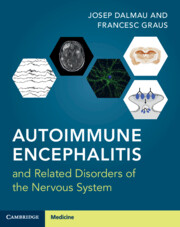Book contents
- Autoimmune Encephalitis and Related Disorders of the Nervous System
- Autoimmune Encephalitis and Related Disorders of the Nervous System
- Copyright page
- Dedication
- Contents
- Clinical Vignettes
- Videos
- Preface
- Abbreviations
- Section 1 Overview
- Section 2 Antibodies and Antigens
- Chapter 4 Antibodies to Intracellular Antigens in CNS Disorders
- Chapter 5 Antibodies to Neural Cell Surface Antigens
- Section 3 Specific Syndromes and Diseases
- Section 4 Autoimmunity in Neurological and Psychiatric Diseases
- Index
- References
Chapter 5 - Antibodies to Neural Cell Surface Antigens
from Section 2 - Antibodies and Antigens
Published online by Cambridge University Press: 27 January 2022
- Autoimmune Encephalitis and Related Disorders of the Nervous System
- Autoimmune Encephalitis and Related Disorders of the Nervous System
- Copyright page
- Dedication
- Contents
- Clinical Vignettes
- Videos
- Preface
- Abbreviations
- Section 1 Overview
- Section 2 Antibodies and Antigens
- Chapter 4 Antibodies to Intracellular Antigens in CNS Disorders
- Chapter 5 Antibodies to Neural Cell Surface Antigens
- Section 3 Specific Syndromes and Diseases
- Section 4 Autoimmunity in Neurological and Psychiatric Diseases
- Index
- References
Summary
Antibodies against cell surface antigens (neuronal or glial) usually recognize conformational epitopes. Therefore, these antibodies can only be detected by techniques that preserve the native conformation of the target antigen, for instance, indirect immunofluorescence with tissue adapted to cell surface or synaptic proteins, cultured neurons, cells transfected with the antigen, or radioimmunoassay. Studies using in-vitro models or passive transfer of antibodies to experimental animals strongly suggest that these antibodies are pathogenic. Some antibodies frequently occur in encephalitis associated with cancer (for example, anti-GABAbR antibodies and small-cell lung cancer), but the incidence of cancer is usually lower than that observed in patients with onconeural antibodies. Two antibodies against surface antigens, DNER (Tr) and amphiphysin, are exceptions to the characteristics mentioned above as they recognize linear epitopes and are considered biomarkers of paraneoplastic neurological syndromes associated with Hodgkin lymphoma (DNER) or small-cell lung cancer (amphiphysin). Antibodies against AMPAR, GABAbR, and LGI1 usually associate with limbic encephalitis. Other antibodies characteristically associate with distinct syndromes, for example, anti-NMDAR encephalitis that manifests with a highly characteristic neuropsychiatric syndrome; CASPR2 antibodies that can manifest as Morvan syndrome; aquaporin 4 antibodies that typically associate with neuromyelitis optica spectrum disorders, and glycine receptor antibodies that predominantly associate with progressive encephalomyelitis with rigidity and myoclonus (a disorder in the spectrum of stiff-person syndrome). Antibodies against GABAaR, MOG, and GluK2 subunit of the kainate receptor occur with different types of encephalitis characterized by multiple FLAIR/T2 hyperintense lesion in the brain MRI.
Keywords
- Type
- Chapter
- Information
- Publisher: Cambridge University PressPrint publication year: 2022
References
- 1
- Cited by

